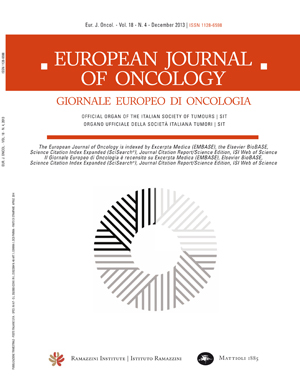Emergency surgery for colon carcinoma in the elderly: audit of a 13-yr experience
Keywords:
colon cancer, emergency surgery, elderly, auditAbstract
Aim: The incidence of colon carcinoma progressively increases with age. The initial presentation may be a surgical emergency associated with increased morbidity and mortality in up to 15% of cases. The aim of this study was to perform a retrospective audit of our experience with emergency surgery for colon carcinoma in the elderly in the last 13 years. Materials and methods: From January 2000 to December 2012 we performed 879 emergency operations, of which 123 addressed colon diseases (14%), 41 colon carcinoma (1/3 of colon cases, 4.6% of the total number) on an emergency basis. Patients (pt’s) were divided into 2 age groups: A ≥75 years and B ≤74. Fourteen factors were investigated: age, gender, pre-operative ASA score, clinical presentation, types of operation, associated procedures, distribution among surgeons, tumor location, TNM stage, Hinchey stage when applicable, associated pathology, post-operative length of stay, complications, mortality. Data were recorded on a Microsoft Access 2007 database. Results: Distribution among sexes was even. A prevalent ASA III score occurred in group B. Resection was mostly performed in both groups. No differences were recorded regarding location, indication, type of operation, post-operative stay. An association was noticed between age and the following items: TNM stage, i.e. group B showed more advanced stages, complications, i.e. more complications in group A and mortality which was higher in group A. Conclusions: Age should not be an absolute indicator to decide on a possibly life-saving emergency procedure for colon carcinoma but worse outcomes may be expected in older pt’s.Downloads
Published
Issue
Section
License
OPEN ACCESS
All the articles of the European Journal of Oncology and Environmental Health are published with open access under the CC-BY Creative Commons attribution license (the current version is CC-BY, version 4.0 http://creativecommons.org/licenses/by/4.0/). This means that the author(s) retain copyright, but the content is free to download, distribute and adapt for commercial or non-commercial purposes, given appropriate attribution to the original article.
The articles in the previous edition of the Journal (European Journal of Oncology) are made available online with open access under the CC-BY Creative Commons attribution license (the current version is CC-BY, version 4.0 http://creativecommons.org/licenses/by/4.0/).
Upon submission, author(s) grant the Journal the license to publish their original unpublished work within one year, and the non exclusive right to display, store, copy and reuse the content. The CC-BY Creative Commons attribution license enables anyone to use the publication freely, given appropriate attribution to the author(s) and citing the Journal as the original publisher. The CC-BY Creative Commons attribution license does not apply to third-party materials that display a copyright notice to prohibit copying. Unless the third-party content is also subject to a CC-BY Creative Commons attribution license, or an equally permissive license, the author(s) must comply with any third-party copyright notices.

